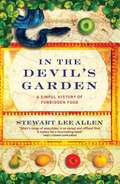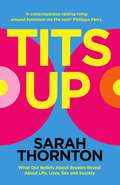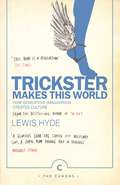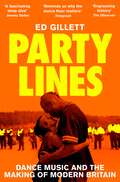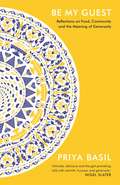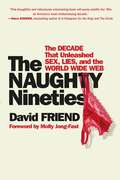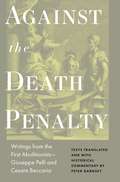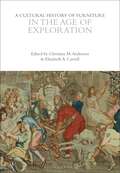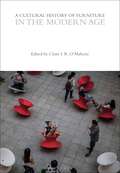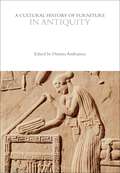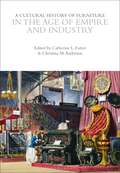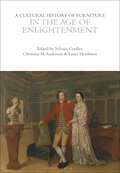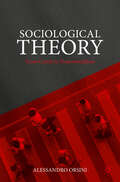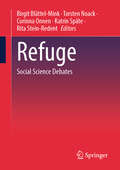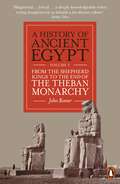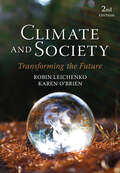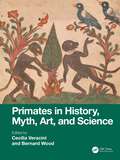- Table View
- List View
In The Devil's Garden: A Sinful History of Forbidden Food
by Stewart AllenFrom the forbidden fruit of the Old Testament to the numerous laws broken at Francois Mitterand's final meal, In the Devil's Garden is a mouth-watering history of food taboos from around the world - a smorgasbord of culinary titbits to spice up any after-dinner conversation. In a history peppered with religious extremists who would rather starve to death than violate ancient taboos, and in an age when half the world's population - from cow-loving Hindus to Kosher Jews and Western vegetarians - still live with harsh dietary restrictions, Allen reveals just how significant, and pervasive, our relationship with food is.
Tits Up: What Our Beliefs About Breasts Reveal About Life, Love, Sex and Society
by Sarah ThorntonBoobs. Knockers. Jugs. Cans. Baps. Melons. Puppies. Fun bags. Bosoms. Hooters.In the English language there are over 700 expressions for female mammary glands – the majority of which are mostly used by men. In Tits Up, bestselling author, sociologist and journalist Sarah Thornton asks how is it that we look at breasts so much, but reflect on them so little.It was after Sarah underwent a double mastectomy and reconstructive surgery that she found herself considering how we think about breasts, and what that tells us about ourselves. Across five chapters, she encounters strippers, plastic surgeons, bra designers, modern witches, lactation experts and donors to breast milk banks to create the ultimate biography of humanity's most culturally important body part.Surprising, sharp, tender and true, Tits Up explores how women’s chests shape our ideas of beauty,health, respect, self-esteem and equality. Blending real-life accounts with sociology, history, art andculture, and written with refreshing optimism and wit, Thornton has one overriding ambition to: liberate breasts from centuries of patriarchal prejudice.
Trickster Makes This World: How Disruptive Imagination Creates Culture. (Canons Ser. #59)
by Lewis HydeTrickster disrupted the world around him, and in doing so he reshaped it. Playful, mischievous, subversive, amoral, tricksters are a great bother to have around, but they are also indispensable heroes of culture. Trickster Makes This World revisits the stories of Coyote, Eshu and Hermes and holds them up against the life and work of more recent creators: Pablo Picasso, Marcel Duchamp, John Cage, Allen Ginsberg, Maxine Hong Kingston and others. Authoritative in its scholarship, supple and dynamic in its style, Trickster Makes This World encourages you to think and see afresh.
Party Lines: Dance Music and the Making of Modern Britain
by Ed Gillett'[An] excellent history of UK dance culture' – Sunday TimesFrom the illicit reggae blues dances and acid-rock free festivals of the 1970s, through the ecstasy-fuelled Second Summer of Love in 1988 to the increasingly corporate dance music culture of the post-Covid era, Party Lines is a groundbreaking new history of UK dance music from journalist and filmmaker Ed Gillett, exploring its pivotal role in the social, political and economic shifts on which modern Britain has been built.Taking in the Victorian moralism of the Thatcher years, the far-reaching restrictions of the Criminal Justice Act in 1994, and the resurgence of illegal raves during the Covid-19 pandemic, Party Lines charts an ongoing conflict, fought in basement clubs, abandoned warehouses and sunlit fields, between the revolutionary potential of communal sound and the reactionary impulses of the British establishment. Brought to life with stunning clarity and depth, this is social and cultural history at its most immersive, vital and shocking.
Be My Guest: Reflections on Food, Community and the Meaning of Generosity
by Priya Basil‘A brave and beautiful exploration into food, race, memory and the very meaning of life. I read it greedily - and so will you’ Meera Sodha, author of Fresh India The dinner table, among friends, is where the best conversations take place – talk about the world, religion, politics, culture, love and cooking. In the same way, Be My Guest is a conversation about all these things, mediated through the sharing of food. We live in a world where some have too much and others not enough, where migrants and refugees are both welcomed and vilified, and where most of us spend less and less time cooking and eating together. Priya Basil explores the meaning and limits of hospitality today, and in doing so she invites us to consider that how much we have in common may depend on what we are willing to share.
The Naughty Nineties: The Triumph of the American Libido
by David FriendA sexual history of the 1990s when the Baby Boomers took over Washington, Hollywood, and Madison Avenue. A definitive look at the captains of the culture wars -- and an indispensable road map for understanding how we got to the Trump Teens.The Naughty Nineties: The Triumph of the American Libido examines the scandal-strafed decade when our public and private lives began to blur due to the rise of the web, reality television, and the wholesale tabloidization of pop culture. In this comprehensive and often hilarious time capsule, David Friend combines detailed reporting with first-person accounts from many of the decade's singular personalities, from Anita Hill to Monica Lewinsky, Lorena Bobbitt to Heidi Fleiss, Alan Cumming to Joan Rivers, Jesse Jackson to key members of the Clinton, Dole, and Bush teams. The Naughty Nineties also uncovers unsung sexual pioneers, from the enterprising sisters who dreamed up the Brazilian bikini wax to the scientists who, quite by accident, discovered Viagra.
Against the Death Penalty: Writings from the First Abolitionists—Giuseppe Pelli and Cesare Beccaria
by Cesare Beccaria Giuseppie PelliThe first known abolitionist critique of the death penalty—here for the first time in EnglishIn 1764, a Milanese aristocrat named Cesare Beccaria created a sensation when he published On Crimes and Punishments. At its centre is a rejection of the death penalty as excessive, unnecessary, and pointless. Beccaria is deservedly regarded as the founding father of modern criminal-law reform, yet he was not the first to argue for the abolition of the death penalty. Against the Death Penalty presents the first English translation of the Florentine aristocrat Giuseppe Pelli's critique of capital punishment, written three years before Beccaria's treatise, but lost for more than two centuries in the Pelli family archives.Peter Garnsey examines the contrasting arguments of the two abolitionists, who drew from different intellectual traditions. Pelli was a devout Catholic influenced by the writings of natural jurists such as Hugo Grotius, whereas Beccaria was inspired by the French Enlightenment philosophers. While Beccaria attacked the criminal justice system as a whole, Pelli focused on the death penalty, composing a critique of considerable depth and sophistication. Garnsey explores how Beccaria's alternative penalty of forced labour, and its conceptualisation as servitude, were embraced in Britain and America, and delves into Pelli's voluminous diaries, shedding light on Pelli's intellectual development and painting a vivid portrait of an Enlightenment man of letters and of conscience.With translations of letters exchanged by the two abolitionists and selections from Beccaria's writings, Against the Death Penalty provides new insights into eighteenth-century debates about capital punishment and offers vital historical perspectives on one of the most pressing questions of our own time.
A Cultural History of Furniture in the Age of Exploration (The Cultural Histories Series)
by Professor Megan AldrichThe 16th and 17th centuries in Europe witnessed a significant paradigm shift. Rooted in medieval beliefs and preoccupations, the exploration so characteristic of the period stemmed from religious motives but came to be propelled by commerce and curiosity as Europeans increasingly engaged with the rest of the world. Interiors in both public and private spaces changed to reflect these cultural encounters and, with them, the furniture with which they were populated. Visually, furniture of this period displayed new designs, forms and materials. In its uses, it also mirrored developments in science, technology, government and social relationships as prints became more widely distributed, the Wunderkammer developed and there was religious strife and resistance to absolute monarchical rule.Drawing upon a wealth of visual and textual sources, this volume presents essays that examine key characteristics of the furniture of the period on the themes of Design and Motifs; Makers, Making, and Materials; Types and Uses; The Domestic Setting; The Public Setting; Exhibition and Display; Furniture and Architecture; Visual Representations; and Verbal Representations.
A Cultural History of Furniture in the Modern Age (The Cultural Histories Series)
Furniture is a unique witness to the transformations of private and public experience amidst the upheavals of the 20th century. How we work, rest and play are determined by the embodied encounter with furniture, defining and projecting a sense of identity and status, responding to and exemplifying contrasting social conditions, political and economic motivations, aesthetic predilections and debates. Assessing physical and archival evidence drawn from a spectrum of iconic and under-represented case studies, an international team of design historians collaborate in this volume to explore key methodological questions about how the production, consumption and mediation of furniture reveal shifting cultural habits and histories across diverse contexts amidst modernity. Drawing upon a wealth of visual and textual sources, this volume presents essays that examine key characteristics of the furniture of the period on the themes of Design and Motifs; Makers, Making, and Materials; Types and Uses; The Domestic Setting; The Public Setting; Exhibition and Display; Furniture and Architecture; Visual Representations; and Verbal Representations.
A Cultural History of Furniture in Antiquity (The Cultural Histories Series)
by Dimitra AndrianouCovering the period from 2500 BCE to the Byzantine Era, this volume focuses on the social history of furniture found in houses, tombs and temples as narrated through the archaeological evidence. The earliest furniture can be seen as an attempt by humans to enhance their safety, comfort and social standing but it can also offer opportunities for understanding human behavior, values and thought: fine furniture was among the most valuable of possessions in the ancient world so it expressed power, wealth and status. It was appreciated as art, used in diplomacy (both as a gift and as tribute) and recorded as booty. At the same time, its practical and ceremonial uses yield important clues about the domestic environment and daily life in antiquity, as well as revealing aspects of sacred belief and funerary practices.Drawing upon a wealth of visual and textual sources, this volume presents essays that examine key characteristics of the furniture of the period on the themes of Design and Motifs; Makers, Making, and Materials; Types and Uses; The Domestic Setting; The Public Setting; Exhibition and Display; Furniture and Architecture; Visual Representations; and Verbal Representations.
A Cultural History of Furniture in Antiquity (The Cultural Histories Series)
Covering the period from 2500 BCE to the Byzantine Era, this volume focuses on the social history of furniture found in houses, tombs and temples as narrated through the archaeological evidence. The earliest furniture can be seen as an attempt by humans to enhance their safety, comfort and social standing but it can also offer opportunities for understanding human behavior, values and thought: fine furniture was among the most valuable of possessions in the ancient world so it expressed power, wealth and status. It was appreciated as art, used in diplomacy (both as a gift and as tribute) and recorded as booty. At the same time, its practical and ceremonial uses yield important clues about the domestic environment and daily life in antiquity, as well as revealing aspects of sacred belief and funerary practices.Drawing upon a wealth of visual and textual sources, this volume presents essays that examine key characteristics of the furniture of the period on the themes of Design and Motifs; Makers, Making, and Materials; Types and Uses; The Domestic Setting; The Public Setting; Exhibition and Display; Furniture and Architecture; Visual Representations; and Verbal Representations.
A Cultural History of Furniture in the Age of Empire and Industry (The Cultural Histories Series)
by Catherine L. Futter and Christina M. AndersonThe 19th century in Western culture was a time of both confidence and turbulence. Industrial developments resulted in a number of benefits from a growing middle class to efficiency, convenience and innovation across a range of fields from engineering to architecture. Alongside these improvements, the century began with the extended period of the Napoleonic Wars and was further disrupted by rebellions and revolutions both within Europe and in India, South America and other parts of the world. Slavery was abolished and urbanization increased dramatically.These myriad developments were reflected throughout the period in the proliferation of types of furniture, along with their categorization as 'industrial art' at the international exhibitions and world fairs and the increasingly adventurous range of materials that were sometimes used in their construction. Nonetheless, a strong antiquarian/historicist strand also prompted interest in the revival of past styles in areas of art and design, including furniture. Drawing upon a wealth of visual and textual sources, this volume presents essays that examine key characteristics of the furniture of the period on the themes of Design and Motifs; Makers, Making, and Materials; Types and Uses; The Domestic Setting; The Public Setting; Exhibition and Display; Furniture and Architecture; Visual Representations; and Verbal Representations.
A Cultural History of Furniture in the Modern Age (The Cultural Histories Series)
by Claire I. R. O’MahonyFurniture is a unique witness to the transformations of private and public experience amidst the upheavals of the 20th century. How we work, rest and play are determined by the embodied encounter with furniture, defining and projecting a sense of identity and status, responding to and exemplifying contrasting social conditions, political and economic motivations, aesthetic predilections and debates. Assessing physical and archival evidence drawn from a spectrum of iconic and under-represented case studies, an international team of design historians collaborate in this volume to explore key methodological questions about how the production, consumption and mediation of furniture reveal shifting cultural habits and histories across diverse contexts amidst modernity. Drawing upon a wealth of visual and textual sources, this volume presents essays that examine key characteristics of the furniture of the period on the themes of Design and Motifs; Makers, Making, and Materials; Types and Uses; The Domestic Setting; The Public Setting; Exhibition and Display; Furniture and Architecture; Visual Representations; and Verbal Representations.
A Cultural History of Furniture in the Age of Enlightenment (The Cultural Histories Series)
by Sylvain Cordier, Christina M. Anderson, and Laura HoulistonThe 18th century saw the height of court culture in Europe as well as the beginnings of its demise with conflicts such as the American and French Revolutions. The Scientific Revolution, which had begun in the preceding centuries, also ushered in a new intellectual era which advocated the use of reason to effect change in government and to advance progress in society. For furniture, this meant ever-higher standards of luxury in the designs, techniques and materials utilized for the best pieces, and more structure and specialization in the furniture-making process itself. Furniture also came into its own during this period as a collectable work of art on its own merits.Drawing upon a wealth of visual and textual sources, this volume presents essays that examine key characteristics of the furniture of the period on the themes of Design and Motifs; Makers, Making, and Materials; Types and Uses; The Domestic Setting; The Public Setting; Exhibition and Display; Furniture and Architecture; Visual Representations; and Verbal Representations.
A Cultural History of Furniture in the Age of Enlightenment (The Cultural Histories Series)
The 18th century saw the height of court culture in Europe as well as the beginnings of its demise with conflicts such as the American and French Revolutions. The Scientific Revolution, which had begun in the preceding centuries, also ushered in a new intellectual era which advocated the use of reason to effect change in government and to advance progress in society. For furniture, this meant ever-higher standards of luxury in the designs, techniques and materials utilized for the best pieces, and more structure and specialization in the furniture-making process itself. Furniture also came into its own during this period as a collectable work of art on its own merits.Drawing upon a wealth of visual and textual sources, this volume presents essays that examine key characteristics of the furniture of the period on the themes of Design and Motifs; Makers, Making, and Materials; Types and Uses; The Domestic Setting; The Public Setting; Exhibition and Display; Furniture and Architecture; Visual Representations; and Verbal Representations.
A Cultural History of Furniture in the Age of Empire and Industry (The Cultural Histories Series)
The 19th century in Western culture was a time of both confidence and turbulence. Industrial developments resulted in a number of benefits from a growing middle class to efficiency, convenience and innovation across a range of fields from engineering to architecture. Alongside these improvements, the century began with the extended period of the Napoleonic Wars and was further disrupted by rebellions and revolutions both within Europe and in India, South America and other parts of the world. Slavery was abolished and urbanization increased dramatically.These myriad developments were reflected throughout the period in the proliferation of types of furniture, along with their categorization as 'industrial art' at the international exhibitions and world fairs and the increasingly adventurous range of materials that were sometimes used in their construction. Nonetheless, a strong antiquarian/historicist strand also prompted interest in the revival of past styles in areas of art and design, including furniture. Drawing upon a wealth of visual and textual sources, this volume presents essays that examine key characteristics of the furniture of the period on the themes of Design and Motifs; Makers, Making, and Materials; Types and Uses; The Domestic Setting; The Public Setting; Exhibition and Display; Furniture and Architecture; Visual Representations; and Verbal Representations.
A Cultural History of Furniture in the Middle Ages and Renaissance (The Cultural Histories Series)
The Middle Ages were marked by dramatic social, economic, political, and religious changes. Diverse regional and local conditions, and varied social classes - including peasant, artisan, merchant, clergy, nobility, and rulers - resulted in differing needs for furniture. The social settings for furniture included official and private residences both grand and humble, churches and monasteries, and civic institutions, including places of governance and learning, such as municipal halls, guild halls, and colleges. This volume explores how furniture contributed to the social fabric within these varied spaces.The chronological range of this volume extends from the fall of the Roman Empire through to the early Renaissance, a period which exhibited a wide array of types, styles, and motifs, including Byzantine, Romanesque, Gothic, and Renaissance. Rural and regional styles of furniture are also considered, as well as techniques of furniture manufacture. Drawing upon a wealth of visual and textual sources, this volume presents essays that examine key characteristics of the furniture of the period on the themes of Design and Motifs; Makers, Making, and Materials; Types and Uses; The Domestic Setting; The Public Setting; Exhibition and Display; Furniture and Architecture; Visual Representations; and Verbal Representations.
A Cultural History of Furniture in the Middle Ages and Renaissance (The Cultural Histories Series)
by Erin J. Campbell and Stephanie R. MillerThe Middle Ages were marked by dramatic social, economic, political, and religious changes. Diverse regional and local conditions, and varied social classes - including peasant, artisan, merchant, clergy, nobility, and rulers - resulted in differing needs for furniture. The social settings for furniture included official and private residences both grand and humble, churches and monasteries, and civic institutions, including places of governance and learning, such as municipal halls, guild halls, and colleges. This volume explores how furniture contributed to the social fabric within these varied spaces.The chronological range of this volume extends from the fall of the Roman Empire through to the early Renaissance, a period which exhibited a wide array of types, styles, and motifs, including Byzantine, Romanesque, Gothic, and Renaissance. Rural and regional styles of furniture are also considered, as well as techniques of furniture manufacture. Drawing upon a wealth of visual and textual sources, this volume presents essays that examine key characteristics of the furniture of the period on the themes of Design and Motifs; Makers, Making, and Materials; Types and Uses; The Domestic Setting; The Public Setting; Exhibition and Display; Furniture and Architecture; Visual Representations; and Verbal Representations.
A Cultural History of Furniture in the Age of Exploration (The Cultural Histories Series)
by Professor Megan AldrichThe 16th and 17th centuries in Europe witnessed a significant paradigm shift. Rooted in medieval beliefs and preoccupations, the exploration so characteristic of the period stemmed from religious motives but came to be propelled by commerce and curiosity as Europeans increasingly engaged with the rest of the world. Interiors in both public and private spaces changed to reflect these cultural encounters and, with them, the furniture with which they were populated. Visually, furniture of this period displayed new designs, forms and materials. In its uses, it also mirrored developments in science, technology, government and social relationships as prints became more widely distributed, the Wunderkammer developed and there was religious strife and resistance to absolute monarchical rule.Drawing upon a wealth of visual and textual sources, this volume presents essays that examine key characteristics of the furniture of the period on the themes of Design and Motifs; Makers, Making, and Materials; Types and Uses; The Domestic Setting; The Public Setting; Exhibition and Display; Furniture and Architecture; Visual Representations; and Verbal Representations.
Sociological Theory: From Comte to Postcolonialism
by Alessandro OrsiniThis textbook analyses the work of classical and contemporary sociological theorists. The first part is dedicated to Comte, Spencer, Marx, Durkheim, Weber, Pareto, and Simmel. The second part covers the major contemporary sociological perspectives: Functionalism, Marxism, Conflict Theory, Symbolic Interactionism, Phenomenological Sociology, and Rational Choice Theory. The third part is devoted to Postmodern Theory, Feminist Theory, Postcolonial Theory, and Race Theory. The author combines academic rigour with clear and accessible language, offering students an in-depth and extensive overview of the main, recurring problems that have troubled sociological theory from its origins to the present day. The textbook uses contemporary examples, analysing how sociological theory can explain the most tragic phenomena of our time, including the war in Ukraine, the Israeli-Palestinian conflict, US-China competition over Taiwan, nuclear proliferation, radicalization, neofascism, white suprematism, jihadism, and terrorism. With pedagogic features aiding learning, this book helps navigate the various approaches, methods, and research that divide sociologists into distinct schools. This textbook is therefore an invaluable tool to any sociology student looking to gain a comprehensive understanding of the foundational thinkers that have shaped the discipline.
Refuge: Social Science Debates
by Birgit Blättel-Mink Torsten Noack Corinna Onnen Katrin Späte Rita Stein-RedentThe welcome culture of 2015 in Germany has, not least due to the (re)definition of safe countries of origin, turned into a deportation policy. How can this change in policy be understood and is it also accompanied by a change of attitude among the population? Which reasons for and which reasons against the admission of refugees are cited in social debates? This volume brings together analyses of the social discourse on dealing with refugees, questions of labour market integration and the practice of counselling refugees. Alongside academic analyses are reflective contributions from the practice of migration policy.With contributions by Olaf Struck.- David Stiller.- Helge Döring and Sebastian Kurtenbach.- Ann-Christine Lill, Janis Schneider and Sam Schneider.- Kirsten Hoesch. - Kathrin Weis.- Theresa Köhler and Kerstin Ettl.- Doris Beer.- André Pohlmann.- Katharina Resch, Gertraud Kremsner, Michelle Proyer, Camilla Pellech, Regina Studener-Kuras and Gottfried Biewe.The editors: Prof. Dr. Birgit Blättel-Mink is Professor of Sociology with a focus on industrial and organizational sociology at the Goethe University in Frankfurt/Main. Torsten Noack, M.A. Sociology, Head of the School for Work Education of the International Federation Stuttgart. Prof. Dr. Corinna Onnen is university professor for general sociology at the University of Vechta. Dr. Katrin Späte works at the Institute for Sociology at the University of Münster. Apl. Prof. Dr. Rita Stein-Redent works at the University of Vechta.
A History of Ancient Egypt, Volume 3: From the Shepherd Kings to the End of the Theban Monarchy
by John RomerThe final chapter in the definitive, three-volume history of the world's first known stateArchaeologist John Romer has spent a lifetime chronicling the history of Ancient Egypt, and here he tells the epic story of an era dominated by titans of the popular imagination: the radical iconoclast Akhenaten, the boy-king Tutankhamun and the all-conquering Ramesses II. But 'heroes' do not forge history by themselves. This was also a time of international trade, cultural exchange and sophisticated art, even in the face of violent change.Alongside his visionary new history of this, the most famous period in the long history of Ancient Egypt, Romer turns a critical eye on Egyptology itself. Paying close attention to the evidence, he corrects prevailing narratives which cast the New Kingdom as an imperial state power in the European mould. Instead, he reveals - through broken artefacts in ruined workshops, or preserved letters between a tomb-builder and his son - a culture more beautiful and beguiling than we could have imagined.Romer carefully reconstructs the real story of the New Kingdom as evidenced in the archaeological record, and the result - the final volume of a life long project - secures his status as Ancient Egypt's finest chronicler.
Brave New Words: How AI Will Revolutionize Education (and Why That’s a Good Thing)
by Salman Khan‘Salman Khan has long been on the cutting edge of education, and in Brave New Words, he shows us what’s next. The book is a timely master class for anyone interested in the future of learning in the AI era. No one has thought more about these issues—or has more interesting things to say about them’ Bill GatesWhether we like it or not, the AI revolution is coming to education. In Brave New Words, Salman Khan, the visionary behind Khan Academy, explores how artificial intelligence and GPT technology will transform learning, offering a roadmap for teachers, parents, and students to navigate this exciting (and sometimes intimidating) new world.A pioneer in the world of education technology, Khan explains the ins and outs of these cutting-edge tools and how they will forever change the way we learn and teach. Rather than approaching the ChatGPT revolution with white-knuckled fear, Khan wants parents and teachers to embrace AI and adapt to it (while acknowledging its imperfections and limitations). He emphasizes that embracing AI in education is not about replacing human interaction but enhancing it, so that every student can complement the work they're already doing in profoundly new and creative ways, to personalize learning, adapt assessments, and support success in the classroom, preparing students for an increasingly digital future.But Brave New Words is not just about technology - it's about what this technology means for our society, and the practical implications for administrators, guidance counsellors, and hiring managers who can harness the power of AI in education and the workplace. Khan also delves into the ethical and social implications of AI and GPT, offering thoughtful insights into how we can use these tools to build a more accessible education system for students around the world.
Climate and Society: Transforming the Future
by Robin Leichenko Karen O'BrienThis bold and passionate textbook has become a go-to introduction to current and emerging thinking on the social dimensions of climate change, presenting key concepts and frameworks for understanding the multifaceted connections between climate and society. Using clear language and powerful examples, Robin Leichenko and Karen O'Brien explore the varied social drivers, impacts, and responses to climate change. They highlight the important roles that worldviews, values, and – especially in this updated edition – emotions play in shaping interpretations of climate challenges. They include additional material on climate justice and equity, eco-centric discourses, paradigm shifts, and other topics. Situating climate change within the context of a rapidly changing world, the book demonstrates how dynamic political, economic, and environmental contexts amplify risks, often unequally for different groups based on race, gender, wealth, and location. Yet these shifting conditions also present opportunities for transformative responses: the new edition strengthens its emphasis on individuals’ power to influence systems, structures, and cultures. With updated references, examples, and data, and expanded pedagogical features, this informative and engaging new edition empowers undergraduates across the social sciences and other disciplines with a broader and deeper understanding of climate change and the potential for equitable and sustainable responses.
Primates in History, Myth, Art, and Science
by Cecilia Veracini Bernard WoodNon-human primates (hereafter just primates) play a special role in human societies, especially in regions where modern humans and primates co-exist. Primates feature in myths and legends and in traditional indigenous knowledge. Explorers observed them in the wild and brought them, at great cost, to Europe. There they were valued as pets and for display, their images featured in art and architecture, and where they were literally teased apart by scientists. The international team of contributors to this book draws these different perspectives together to show how primates helped humans better understand their own place in nature. The book will be of interest to undergraduate and graduate students as well scholars in disciplines ranging from anthropology to art history.Key features: Includes contributions from an international team of historians and natural scientists Integrates various perspectives and perceptions of non-human primates across time and place Summarizes the place of non-human primates in science, art and culture Includes rare early illustrations
